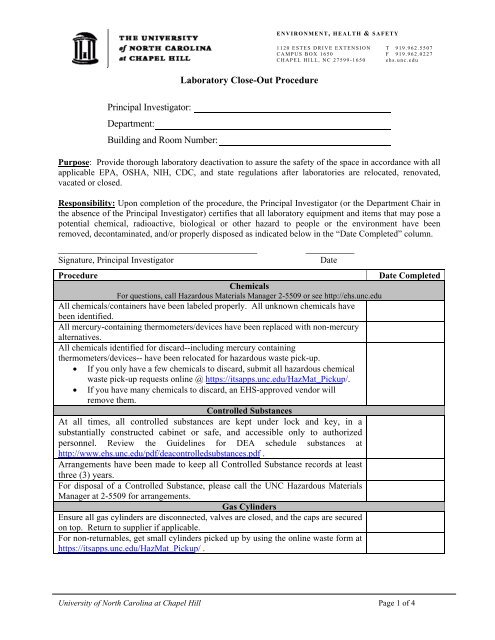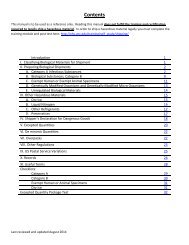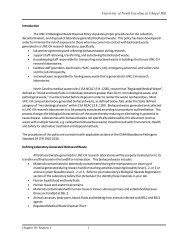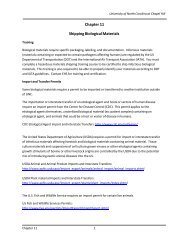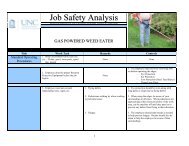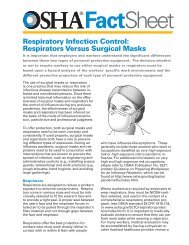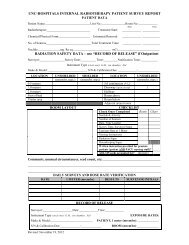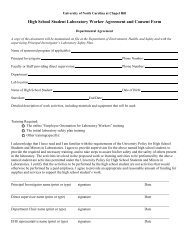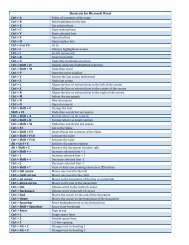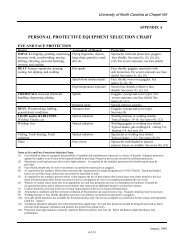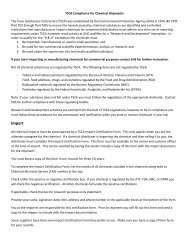Lab Closeout Procedure Checklist - Department of Environment ...
Lab Closeout Procedure Checklist - Department of Environment ...
Lab Closeout Procedure Checklist - Department of Environment ...
Create successful ePaper yourself
Turn your PDF publications into a flip-book with our unique Google optimized e-Paper software.
ENVIRONMENT, HEALTH & SAFETY1120 ESTES DRIVE EXTENSION T 919.962.5507CAMPUS BOX 1650 F 919.962.0227CHAPEL HILL, NC 27599-1650 ehs.unc.edu<strong>Lab</strong>oratory Close-Out <strong>Procedure</strong>Principal Investigator:<strong>Department</strong>:Building and Room Number:Purpose: Provide thorough laboratory deactivation to assure the safety <strong>of</strong> the space in accordance with allapplicable EPA, OSHA, NIH, CDC, and state regulations after laboratories are relocated, renovated,vacated or closed.Responsibility: Upon completion <strong>of</strong> the procedure, the Principal Investigator (or the <strong>Department</strong> Chair inthe absence <strong>of</strong> the Principal Investigator) certifies that all laboratory equipment and items that may pose apotential chemical, radioactive, biological or other hazard to people or the environment have beenremoved, decontaminated, and/or properly disposed as indicated below in the “Date Completed” column.___________________________________________________Signature, Principal InvestigatorDate<strong>Procedure</strong>Date CompletedChemicalsFor questions, call Hazardous Materials Manager 2-5509 or see http://ehs.unc.eduAll chemicals/containers have been labeled properly. All unknown chemicals havebeen identified.All mercury-containing thermometers/devices have been replaced with non-mercuryalternatives.All chemicals identified for discard--including mercury containingthermometers/devices-- have been relocated for hazardous waste pick-up.• If you only have a few chemicals to discard, submit all hazardous chemicalwaste pick-up requests online @ https://itsapps.unc.edu/HazMat_Pickup/.• If you have many chemicals to discard, an EHS-approved vendor willremove them.Controlled SubstancesAt all times, all controlled substances are kept under lock and key, in asubstantially constructed cabinet or safe, and accessible only to authorizedpersonnel. Review the Guidelines for DEA schedule substances athttp://www.ehs.unc.edu/pdf/deacontrolledsubstances.pdf .Arrangements have been made to keep all Controlled Substance records at leastthree (3) years.For disposal <strong>of</strong> a Controlled Substance, please call the UNC Hazardous MaterialsManager at 2-5509 for arrangements.Gas CylindersEnsure all gas cylinders are disconnected, valves are closed, and the caps are securedon top. Return to supplier if applicable.For non-returnables, get small cylinders picked up by using the online waste form athttps://itsapps.unc.edu/HazMat_Pickup/ .University <strong>of</strong> North Carolina at Chapel Hill Page 1 <strong>of</strong> 4
<strong>Lab</strong>oratory <strong>Closeout</strong> <strong>Procedure</strong><strong>Procedure</strong>Date CompletedBiohazard Materials: Animal and Human TissueDispose <strong>of</strong> preserved human tissue. Human tissue in preservative can be left inspecimen containers. If there are many specimen containers with the samepreservative, the specimen containers should be placed into a wide mouth plasticcontainer for hazardous waste pickup. Submit waste forms online athttps://itsapps.unc.edu/HazMat_Pickup/ . It must be indicated on the waste form“tissue is non-infectious”. Infectious prions could be present in brain tissuepreserved in formalin. Contact the Biological Safety Division at 962-5507 fordisposal procedure <strong>of</strong> human brain tissue preserved in formalin.Dispose <strong>of</strong> preserved animal tissue. Animal tissue in preservative can be left inspecimen containers. If there are many specimen containers with the samepreservative, the specimen containers should be placed into a wide mouth plasticcontainer for hazardous waste pickup. Submit waste forms online athttps://itsapps.unc.edu/HazMat_Pickup/ .Animal and human tissue that is not preserved must be placed in a biohazard bag andautoclaved. Contact DLAM for disposal <strong>of</strong> animal tissue. Contact the BiologicalSafety Division at 962-5507 for pick up <strong>of</strong> human tissue after autoclaving.If cultures are being left behind in the lab, someone has to be responsible for them.Transfer responsibility <strong>of</strong> samples to:Questions? Call the Biological Safety Division at 962-5507.Biohazard Materials: Microorganisms and CulturesFor questions, call Biological Safety Division 2-5507 or see http://ehs.unc.eduFor approved biohazard waste collection procedures, refer to the Biohazard WasteDisposal Chart at http://ehs.unc.edu/ih/biological/docs/disposal_chart.pdf .All biohazard waste must be treated prior to final disposal. Refer to the autoclavewaste treatment policy at http://ehs.unc.edu/ih/biological/policy.shtml#policy7 .Liquid biohazard waste is to be autoclaved in vented containers on the liquid cycle <strong>of</strong>the autoclave. Once cool, it can be flushed down the sink.Users should transfer cultures to back-up incubators prior to beginning theprocedures listed below.• The moving and reconnection <strong>of</strong> incubators will be done in two stages so thatcultures can stay behind in back-up incubators until incubators in the new locationare up and running.• Schedules should be made to explain in detail the timing <strong>of</strong> disconnecting/draining/reconnecting for the incubators.• Users will drain incubators and prepare them for moving.• CO2 tanks should be in place in the new building and ready for connection toincubators.• Users will bring water, etc. to the new building and will be responsible forrefilling.Decontaminate all laboratory surfaces with the appropriate disinfectant.After thorough surface decontamination is complete, remove or deface all biohazardand carcinogen signage in the laboratory and on the laboratory door.If cultures are being left behind in the lab, someone has to be responsible for them.Transfer responsibility <strong>of</strong> cultures to:For biosafety cabinets (aka “tissue culture hoods”) , refer to the <strong>Lab</strong>oratoryEquipment section below.University <strong>of</strong> North Carolina at Chapel Hill Page 2 <strong>of</strong> 4
<strong>Lab</strong>oratory <strong>Closeout</strong> <strong>Procedure</strong><strong>Procedure</strong>Date CompletedRadioactive MaterialsFor questions call 2-5507 or see Radiation Safety FAQ, “Moving Your <strong>Lab</strong>oratory” at http://ehs.unc.eduPrepare Radioactive waste for pick-up and use the online form found at:https://itsapps.unc.edu/HazMat_Pickup/.For all types <strong>of</strong> lead; bricks, lead pigs, shielding, source containers, etc., do wipetests, and attach results to the e-102 form found online at:https://itsapps.unc.edu/HazMat_Pickup/.Email Radiation Safety at radiation_safety_<strong>of</strong>fice@unc.edu to change permit to newlocale.Exit survey <strong>of</strong> rooms and equipment is required!RecyclablesTo schedule pick-up, contact Office <strong>of</strong> Waste Reduction/Recycling; 2-1442Large quantities, overflows, or confidential paper pick-upshttp://www.fac.unc.edu/WasteReduction<strong>Lab</strong>oratory EquipmentClean and defrost refrigerators/freezers.Units that may contain refrigerants must be evaluated by Facilities ServicesRefrigeration Shop (2-1087) to determine if refrigerant needs to be removed. Ifrefrigerant needs to be removed, submit a work order to Facilities Services CustomerService (2-3456). The <strong>Department</strong> or owner pays for removal.For equipment that may be contaminated with radioactive material, decontaminate,remove warning stickers, and complete a Safety Clearance Form and attach it to theunit prior to calling. For information, call 2-5507 or see Radiation Safety FAQ, athttp://ehs.unc.edu/radiation/faq.shtml .For equipment that may be contaminated with chemicals or biological material,decontaminate, remove warning stickers, and complete a Safety Clearance Form(http://ehs.unc.edu/ehs/docs/safety_clearance_form.pdf) and attach it to the unit priorto calling. For information, call 2-5507 or see Radiation Safety FAQ, athttp://ehs.unc.edu/radiation/faq.shtml.For equipment (including refrigerators, freezers, incubators, drying ovens) that maybe contaminated with chemicals or biological material, decontaminate according tomanufacturers recommendations with an appropriate disinfectant. Remove or defacewarning stickers, complete a Safety Clearance Form(http://ehs.unc.edu/ehs/docs/safety_clearance_form.pdf) and attach it to theequipment.When cleaning the incubators in the event <strong>of</strong> bacterial or fungal contamination,flasks and culture plates shall be moved to a Biological Safety Cabinet. Shelvesshall be moved to sink for wipe down with 10% bleach followed by a thorough wipedown with disposable towels soaked in 70% ethanol.Biological Safety Cabinets must be decontaminated with formaldehyde gas beforethey can be moved or discarded and when it is being left in the lab for another user.If the cabinet is relocated, recertification will be required. Please call 962-5722 toschedule decontamination and recertification <strong>of</strong> cabinets.BSL3 laboratories must be decontaminated with formaldehyde gas or vaporizedhydrogen peroxide when the laboratory is vacated. Please contact the BiologicalSafety Division at 962-5507 for information.Post completed Safety Clearance Form on entry door to lab(http://ehs.unc.edu/ehs/docs/safety_clearance_form.pdf).Clean all laboratory surfaces.University <strong>of</strong> North Carolina at Chapel Hill Page 3 <strong>of</strong> 4
<strong>Lab</strong>oratory <strong>Closeout</strong> <strong>Procedure</strong><strong>Procedure</strong>Surplus Property<strong>Lab</strong> equipment that you intend to discard must be decontaminated as describedabove. Complete the Surplus Property Clearance sticker and affix to the equipment.(Stickers can be obtained by calling EHS.)For other discarded lab equipment, notify your <strong>Department</strong> manager; call SurplusProperty (2-2134) and complete forms. Call the University Moving Crew (2-0662)to arrange for transportation <strong>of</strong> equipment to Surplus Property. (If Surplus Propertydetermines that the equipment should be scrapped, it will be taken to the OrangeCounty Recycling Facility at no charge.)If you intend to discard a chemical hood that has a Vent Alert alarm on it, pleasecontact EHS at 962-5507 so that the alarm can be removed and returned to EHS.Surplus Property website: http://finance.unc.edu/material--disbursementservices/surplus-property/welcome.htmlSharpsClean out all laboratory drawers. Dispose <strong>of</strong> all sharp items (glass, pipettes,syringes) or, if unused, transfer to another laboratory.To purchase metal can for sharps, order from Fisher (Fisher #5001069EA).For biohazard sharps, use metal container (Fisher #5001069EA) that is properlylabeled (http://ehs.unc.edu/ih/lab/labels/docs/biohaz_needles.pdf), follow autoclaveprocedure, and then discard in normal trash.For radioactive sharps, use a plastic sharps container, then dispose <strong>of</strong> using onlinee-102 form, https://itsapps.unc.edu/HazMat_Pickup/.For sharps that do not contain any <strong>of</strong> the hazards listed above, use metal container(Fisher #5001069EA) that is properly labeled (http://ehs.unc.edu/ih/lab/labels/docs/non_haz_needles_sharps.pdf), then discard in normal trash receptacle.GlasswareBrown, empty bottles (non-broken): de-face labels then discard in normal trash.Other glassware that is empty: use plastic-lined cardboard box, tape up when done,and then discard in normal trash.Shared <strong>Lab</strong>oratories and Storage AreasSurvey all shared areas to locate and appropriately dispose <strong>of</strong> your hazardousmaterials.Transportation <strong>of</strong> Hazardous MaterialsAll biological materials must be transported in secondary containment that is rigid,puncture resistant, leak pro<strong>of</strong>, and impervious to moisture. The secondary containermust be sealed to prevent leakage and must be labeled with a biohazard label.Carts should be used to transport materials. Do not stack materials or overcrowd thecart.Use indoor hallways to transport materials. Avoid busy, public corridors.Liquid nitrogen must be emptied from dewars before the dewars can be moved.If refrigerators or freezers will be moved with infectious material in them, thematerial in the equipment must be packed in secondary containment. The equipmentmust be taped or shrink wrapped shut. It can then be rolled down the hall.<strong>Lab</strong> Close-out CommunicationA copy <strong>of</strong> this signed and completed form has been mailed to the attention <strong>of</strong><strong>Environment</strong>, Health, and Safety at CB # 1650 or faxed to EHS at 962-0227.Date CompletedUniversity <strong>of</strong> North Carolina at Chapel Hill Page 4 <strong>of</strong> 4


